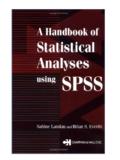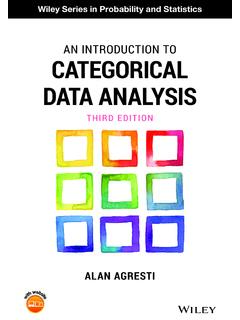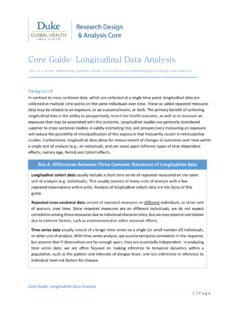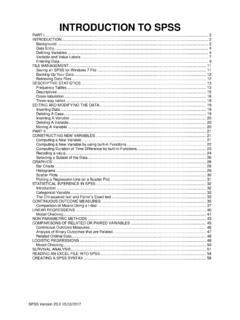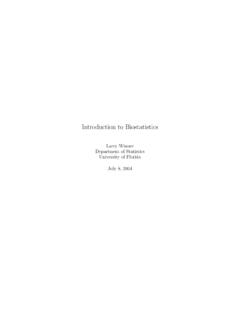Transcription of Unit One
1 UNIT ONEPart variable is an object, characteristic, or property that can have different quantitative variable can be measured in some qualitative variable is characterized by its inability to be measured but it can be sorted into categories. 2 TYPES OF VARIABLESI ndependent variable the presumed cause (of a dependent variable)Dependent variable the presumed effect (of an independent variable)Example: Smoking (IV) Lung cancer (DV)LEVELS OF MEASUREMENT Nominal Ordinal Interval RatioLEVELS OF MEASUREMENTNOMINAL LEVEL OF MEASUREMENT Categories that are distinct from each other such as gender, religion, marital status. They are symbols that have no quantitative value.
2 Lowest level of measurement. Many characteristics can be measured on a nominal scale: race, marital status, and blood type. Dichotomous. Appropriate statistics: mode, frequency We cannot use an average. It would be meaningless LEVEL OF MEASUREMENT The exact differences between the ranks cannot be specified such as it indicates order rather than exact quantity. Involves using numbers to designate ordering on an attribute. Example: anxiety level: mild, moderate, severe. Statistics used involve frequency distributions and percentages. Appropriate statistics: same as those for nominal data , plus the median; but not the mean. INTERVAL LEVEL OF MEASUREMENT They are real numbers and the difference between the ranks can be specified.
3 Equal intervals, but no true zero. Involves assigning numbers that indicate both the ordering on an attribute, and the distance between score values on the attribute They are actual numbers on a scale of measurement. Example: body temperature on the Celsius thermometer as in , etc. means there is a difference of degree in body temperature. Appropriate statistics same as for nominal same as for ordinal plus, the meanRATIO LEVEL OF MEASUREMENT Is the highest level of data where data can categorized, ranked, difference between ranks can be specified and a true or natural zero point can be identified. A zero point means that there is a total absence of the quantity being measured.
4 All scales, whether they measure weight in kilograms or pounds, start at 0. The 0 means something and is not arbitrary (SUBJECTIVE). Example: total amount of TYPE OF DATS TO COLLECT? The goal of the researcher is to use the highest level of measurement possible. Example: Two ways of asking about Smoking behavior. Which is better, A or B?(A)Do you smoke? Yes No(B)How many cigarettes did you smoke in the last 3 days (72 hours)? (A) Is nominal, so the best we can get from this data are frequencies. (B) is ratio, so we can compute: mean, median, mode, AND STATISTIC Parameter is a descriptive measure computed from the data of the population.
5 The population mean, , and the population standard deviation, , are two examples of population parameters. If you want to determine the population parameters, you have to take a census of the entire population. Taking a census is very costly. Parameters are numerical descriptive measures corresponding to populations. Since the population is not actually observed, the parameters are considered unknown constants. Statistic is a descriptive measure computed from the data of the sample. For example, the sample mean, x , and the standard deviation, s, are statistics. They are used to estimate the population parameters. STATISTICS It is a branch of applied mathematics that deals with collecting, organizing, & interpreting data using well-defined procedures in order to make decisions.
6 The term parameter is used when describing the characteristics of the population. The term statistics is used to describe the characteristics of the sample. Types of Statistics: Descriptive Statistics. It involves organizing, summarizing & displaying data to make them more understandable. Inferential Statistics. It reports the degree of confidence of the sample statistic that predicts the value of the population parameter DESCRIPTIVE STATISTICS Measures of Location Measures of Central Tendency: Mean Median Mode Measures of noncentralTendency-Quantiles: Quartiles. Quintiles. Percentiles. Measure of Dispersion (Variability): Range Interquartile range Variance Standard Deviation Coefficient of variation Measures of Shape: Mean > Median-positive or right Skewness Mean = Median-symmetric or zero Skewness Mean < Median-Negative of left Skewness STATISTICAL INFERENCE Is the procedure used to reach a conclusion about a population based on the information derived from a sample that has been drawn from that STATISTICS Inferential statistics are used to test hypotheses (prediction) about relationship between variables in the population.
7 A relationship is a bond or association between variables. It consists of a set of statistical techniques that provide prediction about population characteristics based on information in a sample from population. An important aspect of statistical inference involves reporting the likely accuracy, or of confidence of the sample statistic that predicts the value of the population STATISTICS Bivariate Parametric Tests: One Sample t test (t) Two Sample t test (t) Analysis of Variance/ANOVA (F). Pearson s Product Moment Correlations (r). Nonparametric statistical tests: Nominal data : Chi-Square Goodness-of-Fit Test Chi-Square Test of Independence Nonparametric statistical tests: Ordinal data .
8 Mann Whitney U Test (U Kruskal Wallis Test (H)RESEARCH HYPOTHESIS A tentative prediction or explanation of the relationship between two or more variables It s a translation of research question into a precise prediction of the expected outcomes In some way it s a proposal for solution/s In qualitative research, there is NO hypothesisRESEARCH HYPOTHESIS States a prediction Must always involve at least two variables Must suggest a predicted relationship between the independent variable and the dependent variable Must contain terms that indicate a relationship ( , more than, different from, associated with)HYPOTHESES CRITERIA Written in a declarative form.)
9 Written in present tense. Contain the population Contain variables. Reflects problem statement or purpose statement. Empirically testable. A hypothesis is made about the value of a parameter, but the only facts available to estimate the true parameter are those provided by the sample. If the statistic differs (and of course it will) from the hypothesis stated about the parameter, a decision must be made as to whether or not this difference is significant. If it is, the hypothesis is rejected. If not, it cannot be rejected. H0: The null hypothesis. This contains the hypothesized parameter value which will be compared with the sample value.
10 H1: The alternative hypothesis. This will be accepted only if H0is rejected. Technically speaking, we never accept H0 What we actually say is that we do not have the evidence to reject it. 20 Two types of errors may occur: (alpha) and (beta). The error is often referred to as a Type I error and error as a Type II error. You are guilty of an alpha error if you reject H0when it really is true. You commit a beta error if you accept H0when it is false. 21 TYPES OF ERRORSIf the Null Hypothesis You Reject the null hypothesisTrue (there really are no difference)Made a Type I ErrorReject the null hypothesisFalse (there really are difference) Accept the null hypothesisFalse (there really are difference)Made Type II ErrorAccept the null hypothesisTrue (there really are no difference) H0and H1.










